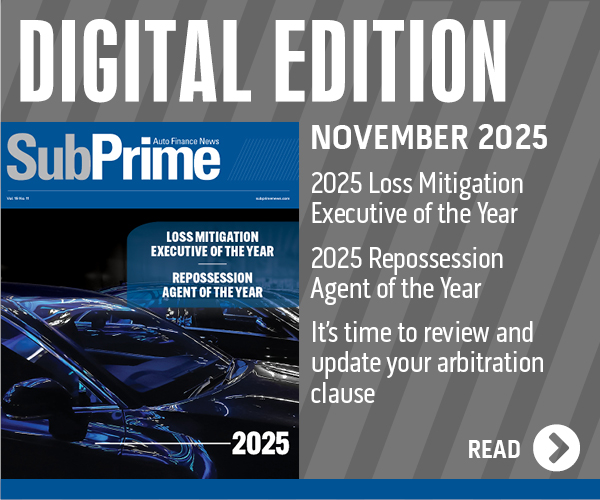2015 depreciation to have minimal impact on ABS losses

By subscribing, you agree to receive communications from Auto Remarketing and our partners in accordance with our Privacy Policy. We may share your information with select partners and sponsors who may contact you about their products and services. You may unsubscribe at any time.
LAWRENCEVILLE, Ga. –
Black Book is projecting that vehicle depreciation will be relatively stable in 2015 — coming in between 14.0 percent and 14.5 percent by the end of year.
As a result, Fitch Ratings believes the depreciation movement will result in only a small impact this year on auto ABS asset performance as well as loss rates.
The two firms made those assertions when Black Book and Fitch Ratings released their latest joint vehicle depreciation report on Tuesday.
“There remains talk of increased interest rates in the near term, and auto lenders are expected to rely more heavily on collateral trends in order to analyze and assess their portfolio to identify continued opportunities for growth,” said Hylton Heard, senior director of Fitch Ratings.
Fitch does expect recovery rates to flatten out and perhaps dip in 2015, given signs of pressure on used vehicle values as volumes entering the market rise in the latter half of the year.
Fitch is observing diverging trends in loss rates in the prime and subprime auto ABS sectors, with subprime losses rising notably year-over-year through June this year, while prime losses have remained low.
Subscribe to Auto Remarketing to stay informed and stay ahead.
By subscribing, you agree to receive communications from Auto Remarketing and our partners in accordance with our Privacy Policy. We may share your information with select partners and sponsors who may contact you about their products and services. You may unsubscribe at any time.
“As mentioned previously, the rise in subprime losses has been driven mostly by lower credit quality, longer loan terms and higher loan-to-values (LTV) in the 2013-2015 subprime securitized pools,” Fitch analysts said. “Collateral and credit quality was strong historically in the prior securitized 2010-2012 subprime ABS transactions when compared to the most recent vintage transactions.
“Depreciation rates have not had much impact on subprime asset performance to date this year, but this could change if recovery rate drop materially but this is not predicted despite pressure on the wholesale vehicle values in the latter half of 2015,” they continued.
In the subprime sector, Fitch reported auto loan ABS 60-day delinquencies hit 4.0 percent in July and were 22 percent above the June reading. The peak in 2015 through June was 4.75 percent, while the historical average was 3.19 percent.
Analysts also pointed out that subprime losses are rising and moved up to 5.39 percent in July, 9 percent above May and 20 percent higher compared to a year earlier. Fitch recollected subprime annualized net losses hit a peak of 8.19 percent back in January, and have exhibited a rising, volatile trend this year.
“The peak subprime loss rate was 10 percent to 13 percent recorded back in early 2009, so despite moving higher this year losses remain well below peak levels,” analysts said. “The 2013-2014 vintages are displaying higher losses relative to the strongest 2010-2012 vintages.”
In the prime space, Fitch noticed auto loan ABS 60-day delinquencies came in at 0.36 percent in July, 9 percent higher versus a year earlier. The firm said delinquencies have ranged from between 0.28 percent to 0.46 percent in 2015, “a relatively tight band and low on a historical level.”
Analysts added prime annualized net losses stood at 0.42 percent through July, up 45 percent over a year ago. They explained the movement by stating, “but loss rates are still very low and June’s level was well below the historical average of 0.93 percent dating back to 2001.” The peak loss rate in 2015 was 0.52 percent through June of this year.
Black Book analysis in the report showed that the supply of used vehicles will continue to increase, ultimately leading to larger depreciation. Annual depreciation on 2- to 6-year-old vehicles was 12.1 percent in 2014, similar to the levels seen in 2012 and 2013.
Analysts called the annual depreciation in 2011 “unbelievably strong” since it was 7.7 percent. They attributed the rate to limited manufacturer vehicle production and low inventory levels, combined with strong pick-up in demand for both new and used vehicles after the recession.
Annual depreciation in pre-recession years ranged from 14 percent to 18 percent, which will put the expected depreciation of 14.5 percent in 2015 at the lower end of the range in peak depreciation periods.
“Demand has remained strong over the last few years, but at this point the attention will turn toward overall supply in the market,” said Anil Goyal, vice president of automotive valuation and analytics for Black Book. “With off-lease vehicles approaching all-time highs in the coming years, we expect that supply will be a primary driver for the accelerating depreciation over the next few years.”
Elsewhere in the report, Fitch indicated that pools of loans and leases securitized will be susceptible to present vehicle segment concentrations.
“This is due to various factors that drive used values by vehicle segment, including gas prices, interest rates, and industries. For example, with the building industry picking up demand for trucks has improved and so have values in 2015,” analysts said.


